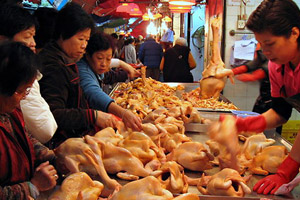Experts mull aftermath of H7N9 outbreak in China

Chinese officials are concluding the bird sampling part of the investigation into the novel H7N9 avian flu virus, as international experts weigh the effect of live-bird market closures, assess diagnostic tests, and explore candidate vaccine viruses.
China’s agriculture ministry has said it has “basically” finished collecting and testing 899,758 samples from across the country, Xinhua, China’s state news agency, reported. Of that number 53 were positive for the H7N9 virus, all but two of them from 18 different live-poultry markets in the city of Shanghai and eight provinces: Anhui, Zhejiang, Jiangsu, Henan, Shandong, Guangdong, Jiangxi, and Fujian.
The remaining positive samples were both from pigeons. One was a wild pigeon from Nanjing, the capital of Jiangsu province, and the other was a domestic one from another city in the same province. None of the positive samples were from farms or pigs.
The agriculture ministry statement said poultry market exposure poses the most danger to humans and that farms should boost efforts to guard against the virus, according to the Xinhua report.
Meanwhile, a team from China and the World Health Organization (WHO) Western Pacific Regional Office (WPRO) surveyed the impact of live-poultry market closures in the wake of the H7N9 outbreak and concluded that human cases declined sharply after officials closed markets. Their findings appeared in the latest issue of the Western Pacific Surveillance and Response Journal.
The researchers focused their view on the market closures in Shanghai, plus Zhejiang and Jiangsu provinces. For example, Shanghai officials launched several measures on Apr 6, which also included culling birds in wholesale markets and disinfecting poultry environments. Researchers noted that the illness onset from the last infected patient from the city was Apr 13.
They found a similar pattern when they looked at market closures in three cities in Zhejiang province and four in Jiangsu province. The last case reported from the cities that had market closures was Apr 17, according to the report.
The drop-off in human cases supports the hypothesis that live-bird markets were the main source of the virus in the areas, but the group said surveillance data in the coming days will show if the control measure was helpful in other provinces.
Researchers also noted that more studies are needed to gauge if certain behaviors in poultry market workers or visitors put them at greater risk of H7N9 infection.
Health officials will have to weigh the benefits and drawbacks of extending or making permanent the live-poultry market closures, with decisions tailored to local situations and needs, the team concluded.
In other developments, researchers from Australia and the Netherlands tested six widely available rapid flu tests to see how useful they would be for detecting H7N9 infections in clinical settings and found that they probably won’t detect most cases, especially late in the illness course.
WHO has reported that two more candidate H7N9 vaccine viruses are now available, raising the total to four. Candidate vaccine viruses are routinely developed for flu viruses that have pandemic potential.
Though no decisions have been made to produce a vaccine against the new virus, scientists can use the candidate viruses to start the first steps in making a vaccine, which can speed the process in case one is needed.
Source: CIDRAP













